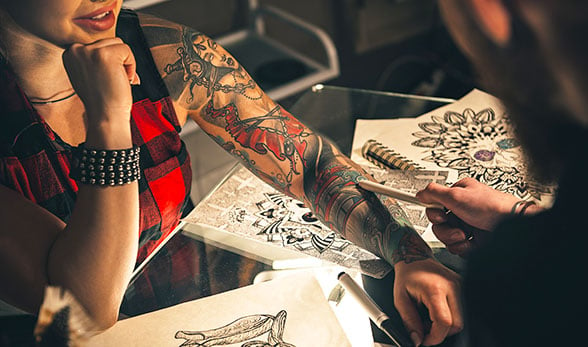Targeting young people with sun-safety education promises the biggest chance of lowering deadly skin cancer rates. The DNA damage that gives rise to the most commonly diagnosed cancer in the United States accumulates, starting with a child’s first sunburn.
But try convincing fun-seeking young adults that a day at the beach or on the slopes could trigger a life-changing cancer down the road and that they should take precautions, and it’s often a hard sell.
Nine years ago, while watching people milling past their sun-safety booth at an outdoor sports expo in Denver, Robert Dellavalle, MD, MSPH, and Barbara Walkosz, PhD, wondered aloud how they could better grab the younger generation’s attention. Then they noticed a common thread.
Tattoos.
Surveys suggest the colorful body art now graces the skin of nearly one in three Americans, with the rates trending close to 50% in the nation’s Millennials (ages 26 to 41).
Five Fast Skin Cancer Facts
Source: Skin Cancer Foundation |
“We thought, BINGO!” said Dellavalle, a professor of dermatology at the University of Colorado School of Medicine and of epidemiology at the Colorado School of Public Health (ColoradoSPH). “If the sun safety is protecting their tattoos as well, they might care a lot more about the issue.”
Winning the National Cancer Institute’s attention with their novel approach, Walkosz and Dellavalle, a CU Cancer Center member, were funded for a national study focused on partnering with tattoo artists for skin cancer-prevention education.
Protecting the artwork and the canvas
“The market is very big,” Dellavalle said of the $1.4 billion-plus tattoo industry, which has grown an average of over 8% each year since 2017, according to market analyst group IBISWorld. “Tattoos don’t have the stigma that they used to have, so more people have one, especially young people.”
Wearers of new tattoos are generally advised to keep their fresh ink covered from the fading rays of the sun in the first weeks and to protect it with sunscreen once it heals. Dellavalle and Walkosz, a CU Denver professor emerita of communication, thought:
Why not use that early education to emphasize the price of sun damage to not only their body’s artwork but to their “canvas” as well?
“Tattoos don’t have the stigma that they used to have, so more people have one, especially young people.” – Robert Dellavalle, MD, MSPH
“If they had a tattoo fade and had to pay for re-inking, or doing it over again, it’s not a cheap prospect,” Dellavalle said. And if they think about how sun damage wrinkles and mottles all of their skin, leaving a bad canvas for any future artwork, sunscreen might become more appealing.
A sense of immortality common among young people makes driving home the skin-cancer message in the younger generation difficult. With surveys suggesting that over a third of people with body art have more than one tattoo, the researchers saw a way of overcoming that message barrier by focusing on preserving the canvas for the artwork, Dellavalle said.
Expanding the breadth of critical message
Raising awareness is critical, particularly in Colorado, the state with the highest per-capita rate of skin cancers. Colorado’s sunny skies, high altitude and all-seasons outdoor recreation from rock climbing to skiing result in high exposure to intense ultraviolet light, and dermatologists are increasingly seeing younger people diagnosed with skin cancers, including melanoma.
Targeting the tattoo population also helps educators reach underrepresented groups with minimal access to sun-safety education, as they visit healthcare settings less often, Walkosz said.
Through the work of a then-NCI-funded fellow, Cristian Gonzalez, MD, the study also specifically included Hispanic tattoo artists with large Hispanic clientele. Gonzalez received the funding to promote diversity, equity and inclusion in cancer research.
While skin cancer rates are lower in darker-skinned populations, the incidence is rising, with Hispanics more likely to be diagnosed later and with worse overall prognoses, Walkosz said.

“The training for the tattoo artists is online – so that it can be scaled and widely disseminated,” Walkosz said of the study-driven program called “Sun Safety Ink!” She and Dellavalle have spoken at major conferences of the National Tattoo Association and the Alliance of Professional Tattoo artists about skin cancer prevention.
“We also had an expert advisory board comprised of dermatologists, public health experts and tattoo artists that guided the development of the program,” said Walkosz, who now works for a private company focused on skin-cancer prevention education.
The goals of the program are to:
-
increase full-body comprehensive sun protection practices (applying sunscreen, wearing hats, wearing sun protective clothing, using shade);
-
decrease sunburning and sun tanning; and
-
decrease positive attitudes regarding tanning and tanning attractiveness.
Early data suggest the project, which involves educating tattoo artists around the country who then educate their clients, has changed client behavior, and the researchers have found a majority of tattoo artists enthusiastic about taking part.
“So dermatologists have found an unexpected strong ally for skin sun safety and skin protection with tattoo artists and tattoo clients,” Dellavalle said. “Bringing the message of protecting your skin from the sun to all populations of Colorado and the nation is critical to decreasing our ever-increasing skin cancer rate.”
Tips for Protecting Your Tattoos and Your Body
-
Sunscreen: Use after the healing period for your tattoo and every day for all of your skin. Apply a broad spectrum (UVA & UVB), SPF 30+ sunscreen 30 minutes before going outdoors. Reapply at least every two hours.
-
Lip Balm: Wear a lip balm with SPF 15+ or higher.
-
Shade: Seek shade from UV rays, especially during midday.
-
Hat: Cover up with a wide-brimmed hat that shades your eyes, face, nose, ears, head and neck.
-
Clothing: Cover up with lightweight long sleeves and pants.
-
Sunglasses: Wear sunglasses that block 100% of UVA & UVB rays.
-
UV Index: Check the current UV Index online. Practice sun safety when the UV Index is 3 or higher, especially during midday.
-
Examine your skin: Watch your moles and other skin spots. Report any unusual skin changes to your doctor.




